Buckle up, amigos y amigas, because we’re about to take a wild ride along Costa Rica’s Pacific Coast! Get ready to experience the wind in your hair, the sun on your face, and the occasional monkey throwing coconuts at your car (just kidding, that’s not a thing…or is it?).
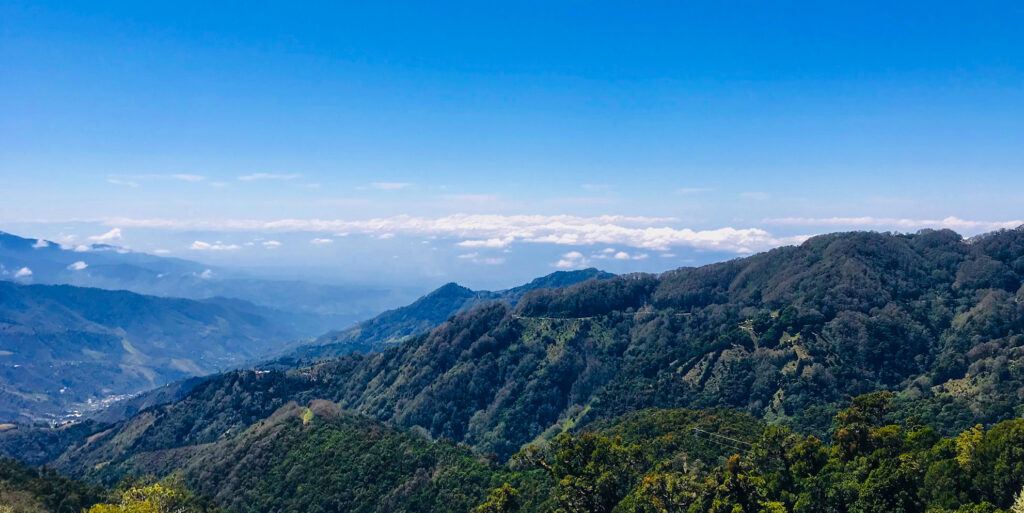
But seriously, this road trip is full of twists, turns, and a bumpy ferry ride or two. So grab your dramamine and your sense of adventure, and let’s hit the road!
I’ve cataloged the specific path I took and the stops and sights I saw along the way. Keep in mind that there are different routes to the Pacific coast and many things to see, so choose what’s best for you, as this is just a fraction of this amazing country.
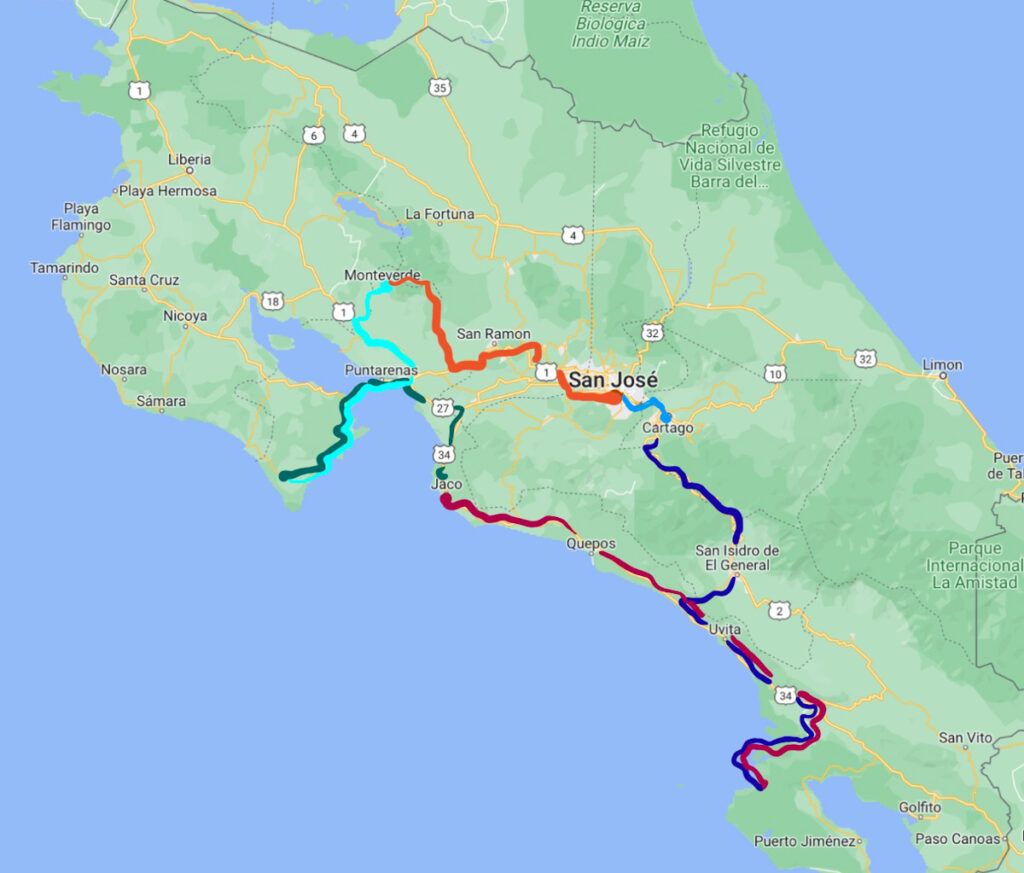
San José
Welcome to San José, Costa Rica, the city that never sleeps — unless it’s nap time! After flying into Juan Santamaria International Airport, this bustling metropolis is the perfect starting point for your Costa Rican adventure. Because I condensed a lot into my ten-day road trip, I decided to immediately get out of the city when I landed.
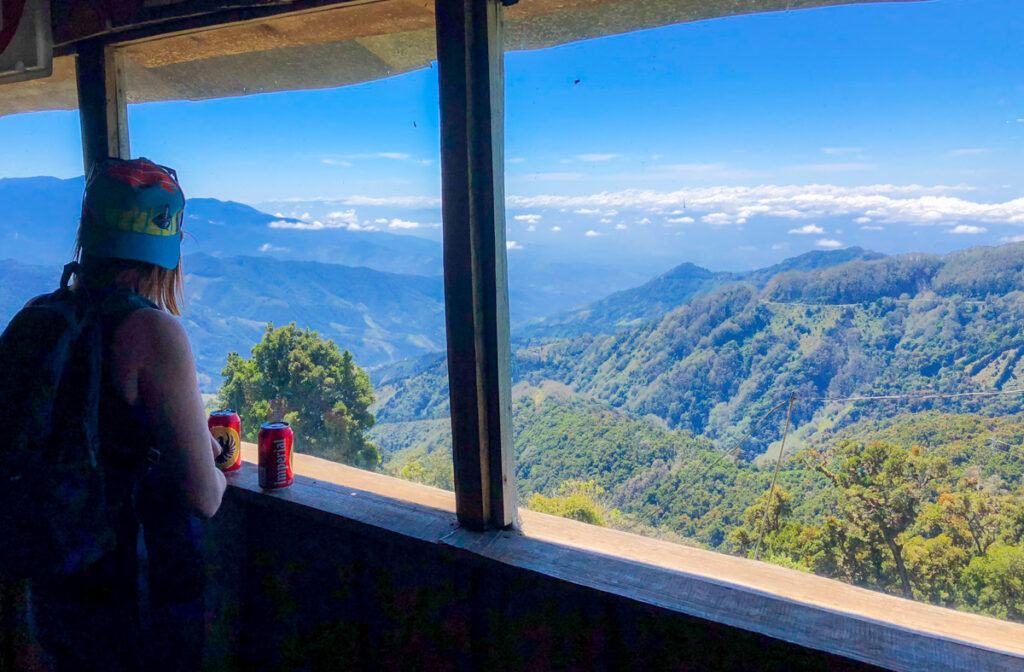
And if you’re not a lover of urban life or dense traffic, then I recommend doing the same. But if your flight is late or you’d prefer to explore city life, then spend a day in Costa Rica’s capital.
Where to Stay in San José
Here’s a list of the best hotels in San José!
Where to Next?
San José to Cartago
- Take Route 2 (Autopista General Cañas) eastbound from San José.
- Continue on Route 2 until you reach the exit for Route 215 (also known as the Florencio del Castillo Highway) toward Cartago.
- Take the Route 215 exit and merge onto the highway.
- Continue on Route 215 for approximately 10 kilometers (about 6 miles) until you reach the city of Cartago.
- Once you enter Cartago, follow the signs to your desired destination.
Driving time: 30–90 minutes, depending on traffic
Cartago
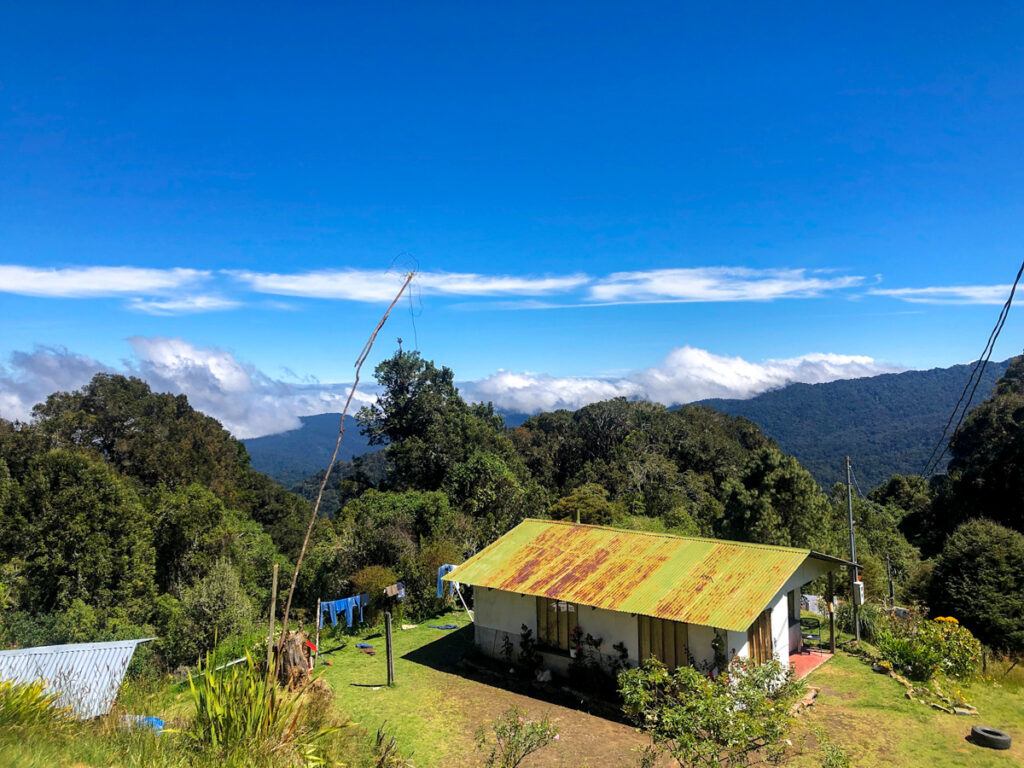
Looking for a place in Costa Rica that’s rich in history, culture, and charm? This quaint city located just 25 kilometers (15.5 miles) east of San José, Cartago is a hidden gem that’s waiting to be explored.
For a taste of history, head to the Ruins of the Santiago Apostol Parish, which was destroyed by an earthquake in 1910. If you’re feeling adventurous, take a hike up to the Irazu Volcano National Park, where you can take in breathtaking views of the surrounding landscape and the impressive volcano.
Where to Stay in Cartago
Budget friendly: Grandpa’s Hotel and Restaurant: Rates start at $86 USD
Midrange: Arte de Plumas Birding Lodge: Rates start at $115 USD
High end: Hotel Quelitales: Rates start at $209 USD
Where to Next?
Cartago to Sierpe
- Head south on Route 2 (Circunvalación) toward San José.
- Take the exit toward Route 27 (Pacific Coast Highway).
- Follow Route 27A (Pacific Coast Highway) for approximately 100 kilometers (62 miles) until you reach the exit for Route 34 toward Quepos/Manuel Antonio.
- Turn right onto Route 34 and continue south for approximately 75 kilometers (47 miles).
- In Palmar Norte, turn right onto Route 245 toward Sierpe.
- Follow Route 245 for approximately 20 kilometers (12 miles) until you reach Sierpe.
Driving time: 4 hours 30 minutes
Osa Peninsula
Home to Corcovado National Park, the Osa Peninsula is a nature lover’s paradise, where you can get up close and personal with monkeys, sloths, and toucans — and that’s just on your way to breakfast! The lush rainforest and translucent waters of the peninsula are ideal for exploring and adventure-seeking, so strap on your hiking boots and get ready to trek through the jungle or dive into the ocean to discover a colorful underwater world.
Sierpe
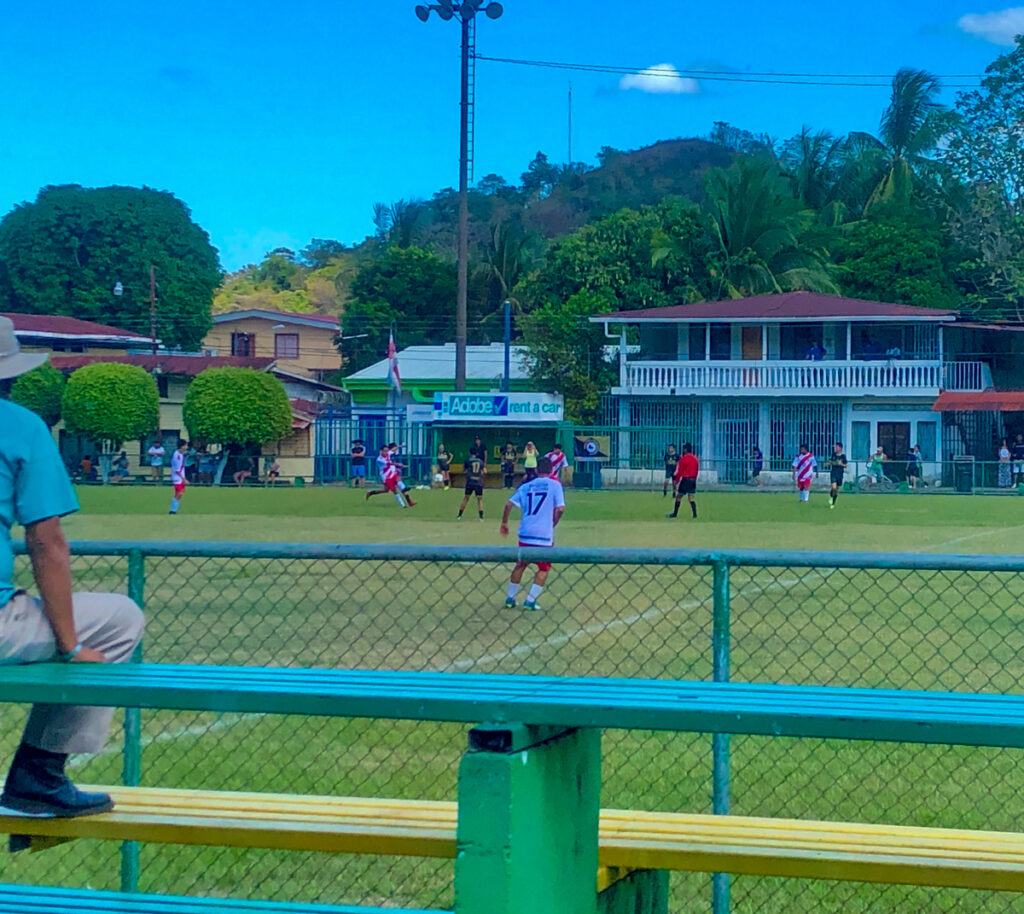
This quiet coastal town may be small, but it packs a punch with its lush mangrove forests, serene river channels, and abundant wildlife. This is your landing spot to reach Corcovado.
Take the ferry to Drake Bay and pass through the waterways of the Sierpe River while marveling at the stunning views of the surrounding rainforest. Keep an eye out for colorful birds, playful monkeys, and even crocodiles lurking beneath the water’s surface.
Where to Stay in Sierpe
Budget friendly: Hotel Margarita: Rates start at $30 USD
Midrange: Hotel Cocodrilo: Rates start at $55 USD
High end: Harmonious House: Rates start at $90 USD
Sierpe to Drake Bay
From Sierpe, take a boat or a water taxi to Drake Bay. The trip takes around 30-40 minutes, depending on the conditions of the sea.
Driving time: 35 minutes
Drake Bay
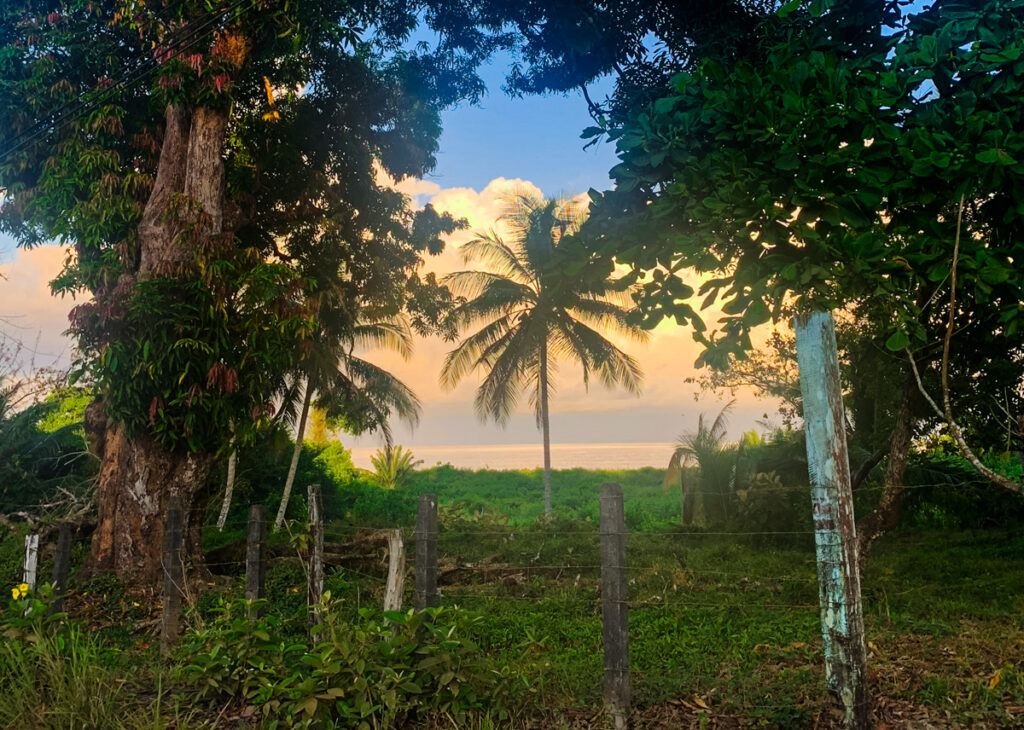
The secluded paradise of Drake Bay on the Osa Peninsula sits at the intersection of relaxation and adventure. Take a dip in the ultramarine waters, explore the vibrant coral reefs, or schedule a tour to explore Corcovado National Park.
Where to Stay in Drake Bay
Budget friendly: Hotel Gitana: Rates start at $54 USD
Midrange: Los Contingas: Rates start at $116 USD
High end: Poor Man’s Paradise Lodge: Rates start at $168 USD
Corcovado National Park
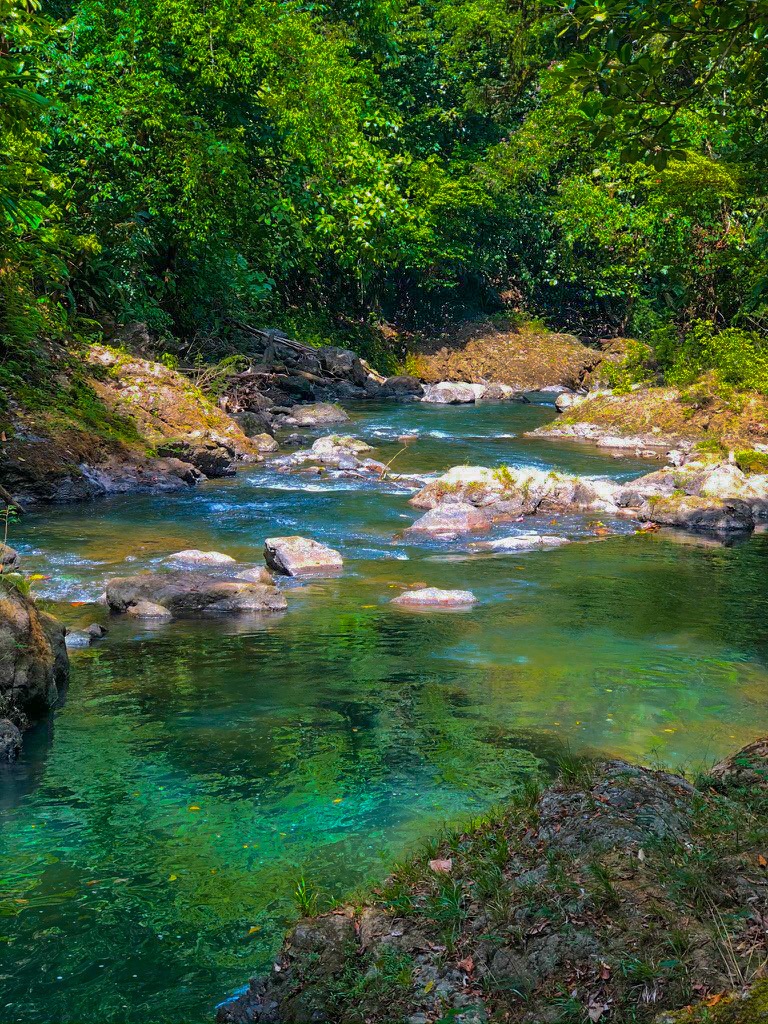
Welcome to Corcovado National Park, the Willy Wonka factory of nature, where there’s something exciting and unexpected around every corner. This rainforest is home to some of the most biodiverse ecosystems on the planet. Hike through dense jungle trails, splash around in hidden waterfalls, and soak in the breathtaking views of the Pacific Ocean.
Keep your eyes peeled for exotic wildlife, like tapirs, monkeys, and scarlet macaws. The park’s hiking trails range from easy to challenging, and if you’re feeling brave, stay overnight at the Sirena Ranger Station for a chance to see pumas, jaguars, and other big cats. If you’re lucky, you might even see some humpback whales breaching in the distance.
Where to Next?
Sierpe to Uvita
- Take the ferry from Drake Bay back to Sierpe
- Take Route 245 north from Sierpe toward Palmar Norte.
- In Palmar Norte, turn left onto Route 34 toward Dominical and Uvita.
- Follow Route 34 for approximately 37 kilometers (23 miles) until you reach Uvita.
Driving time: 90 minutes
Uvita
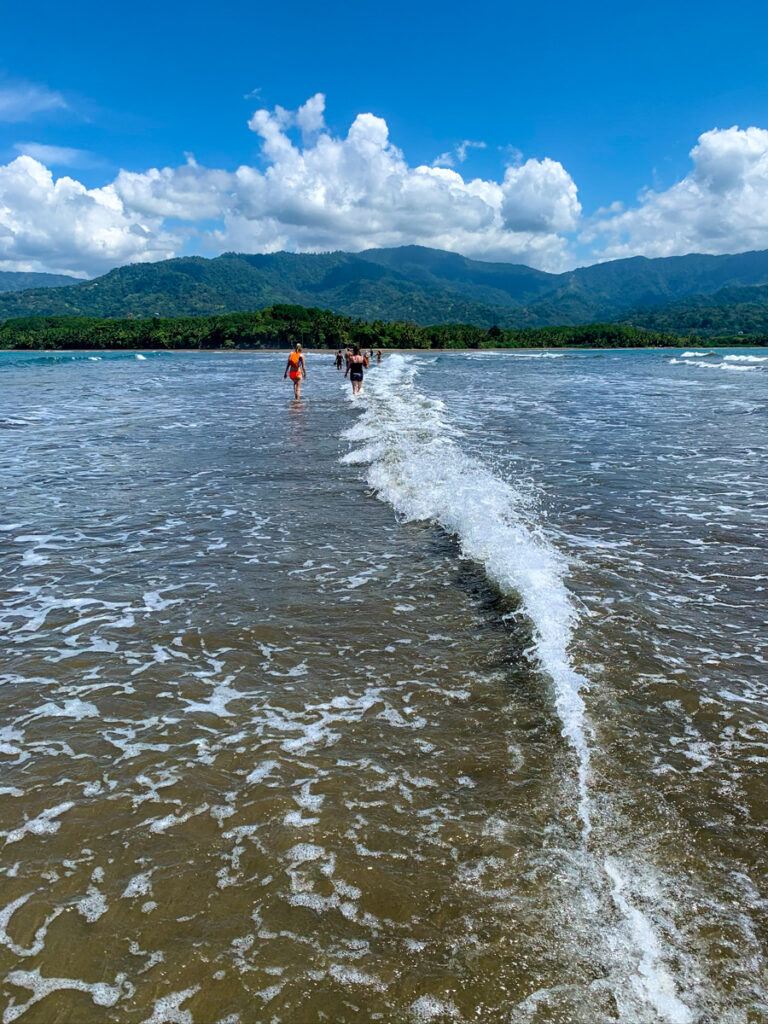
Welcome to Uvita, a small coastal town that’s a haven for adventure seekers, nature lovers, and beach bums alike.
With over 110 hectares (272 acres) of marine and coastal ecosystems, Marina Bellando National Park is one of the most biodiverse areas in Costa Rica.
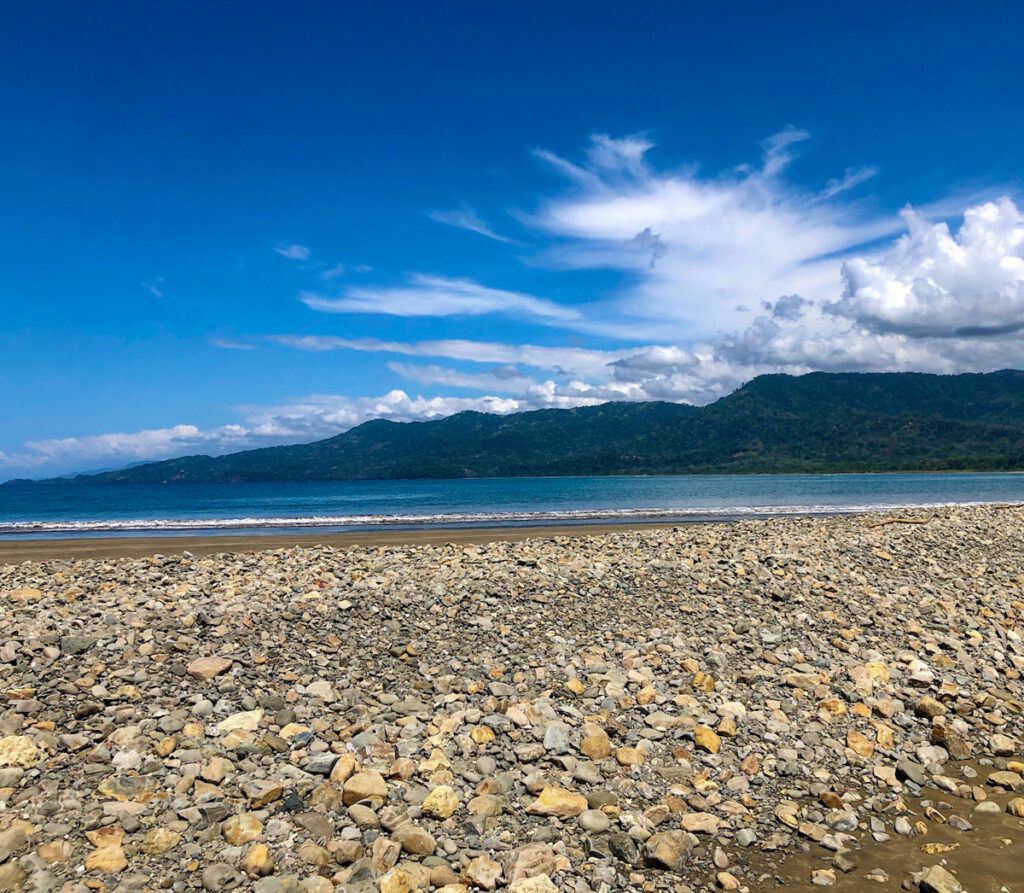
Start your adventure with a visit to the famous Whale’s Tail. This natural rock formation that stretches off the coastline resembles the tail of a humpback whale. When the tide comes in on the Whale’s Tail, it flows in from both sides.
For the more adventurous, head out on a dolphin and whale watching tour, where you can see these majestic creatures up close and personal. Or explore the nearby mangrove forests and observe a variety of birds, reptiles, and other wildlife.
Where to Stay in Uvita
Budget friendly: Cascada Verde Hostel: Rates start at $49 USD
Midrange: Bungalows Ballena: Rates start at $152 USD
High end: Selva Armonia Jungle Resort: Rates start at $189 USD
Where to Next?
Uvita to Dominical
- Take the Costanera Sur road (Route 34) north from Uvita toward Dominical.
- Follow the road for approximately 10 kilometers (6 miles) until you reach Dominical.
Driving time: 20 minutes
Dominical
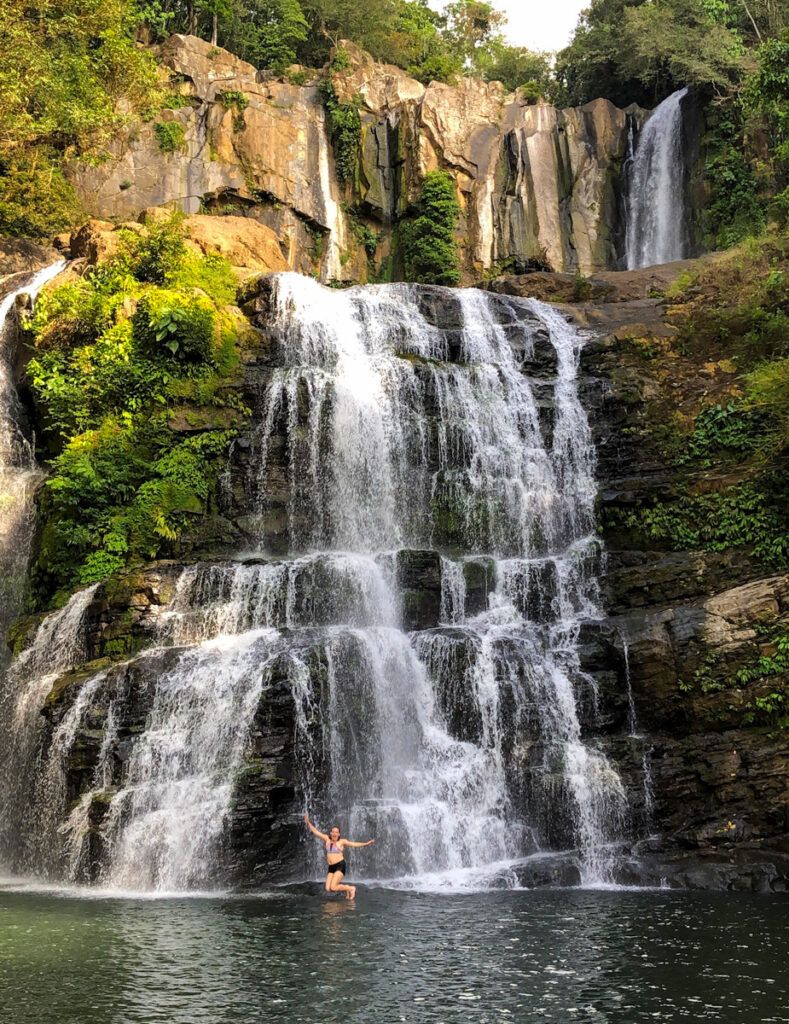
This bohemian surf town is the perfect destination for those seeking a combination of adventure and relaxation.
Whether you’re a seasoned surfer or a beach bum in the making, Dominical is just the place to unwind and enjoy the pura vida lifestyle.
Nauyaca Waterfalls
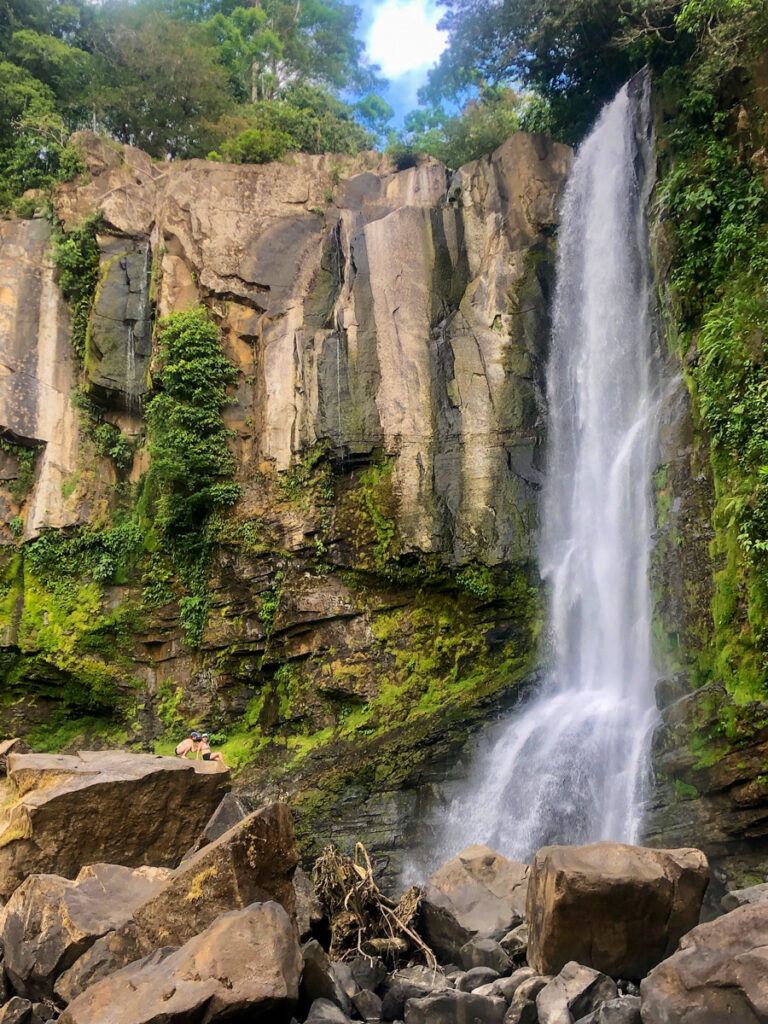
Located in the heart of the jungle, Nauyaca Waterfall offers a refreshing escape from the hustle and bustle of everyday life. But beware, getting there isn’t for the faint of heart!
The trek to the falls requires a bit of hiking and maneuvering over rocky terrain, but it’s worth it for the breathtaking views and the chance to take a dip in the crystal-clear water.
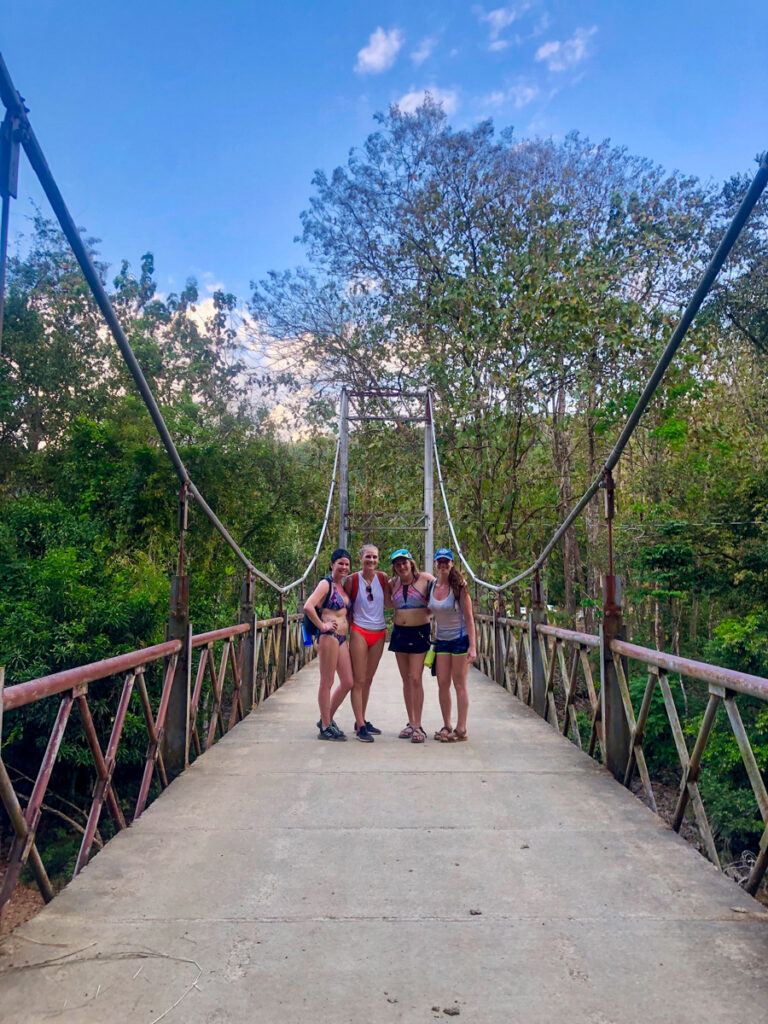
Don’t feel like walking? Take a bus up the mountainside. And make sure to bring your bathing suit: Nauyaca was my favorite place to swim during my entire trip.
For extra fun, hike up to the second level of the falls for a more isolated and unique experience that’s better for climbers than swimmers.
Where to Stay in Dominical
Budget friendly: Hotel Tropical Sands: Rates start at $63 USD
Midrange: Hacienda Baru: Rates start at $121 USD
High end: Pacific Edge Eco Lodge: Rates start at $223 USD
Where to Next?
Dominical to Quepos
- Head northeast on Route 34.
- Follow Route 34 for approximately 30 kilometers (18.6 miles).
- Turn right onto the Costanera Sur Highway (Route 34).
- Follow that for approximately 20 kilometers (12.4 miles) until you reach Quepos.
Driving time: 1 hour
Quepos
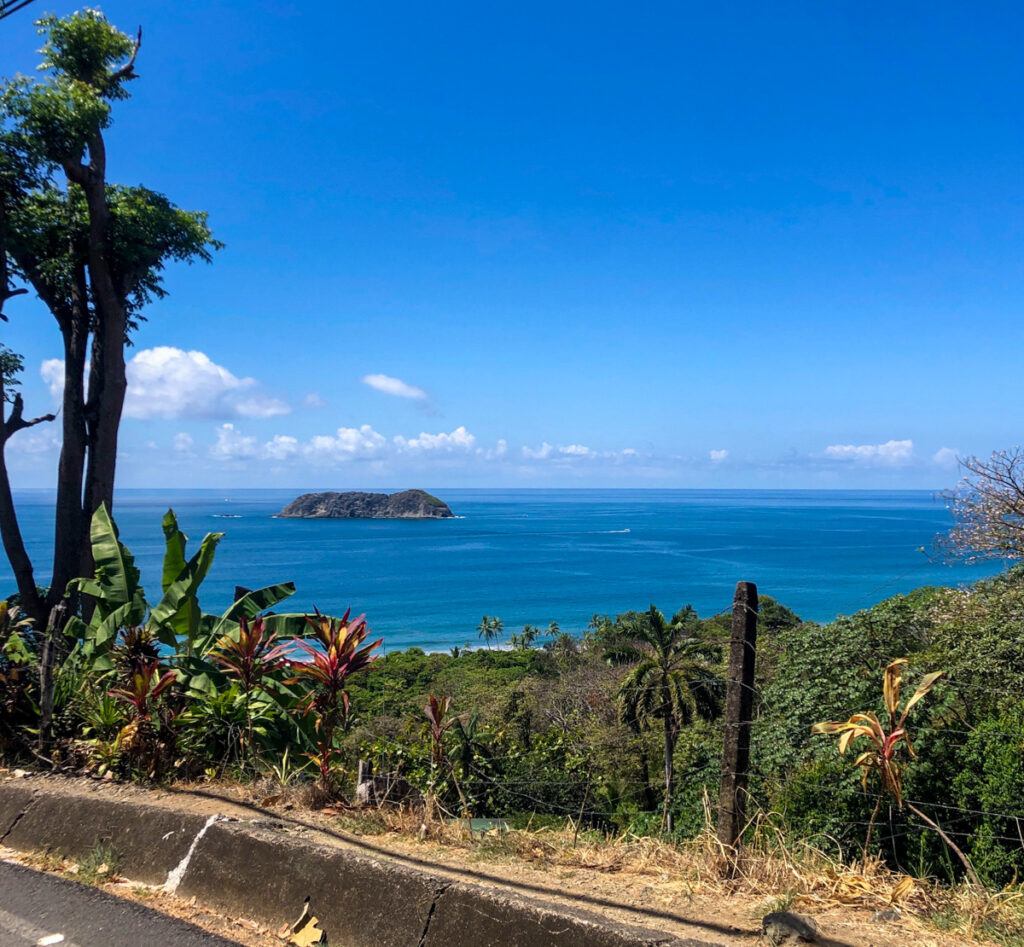
This little town nestled among rainforests, beaches, and waterfalls is home to one of the country’s most famous national parks.
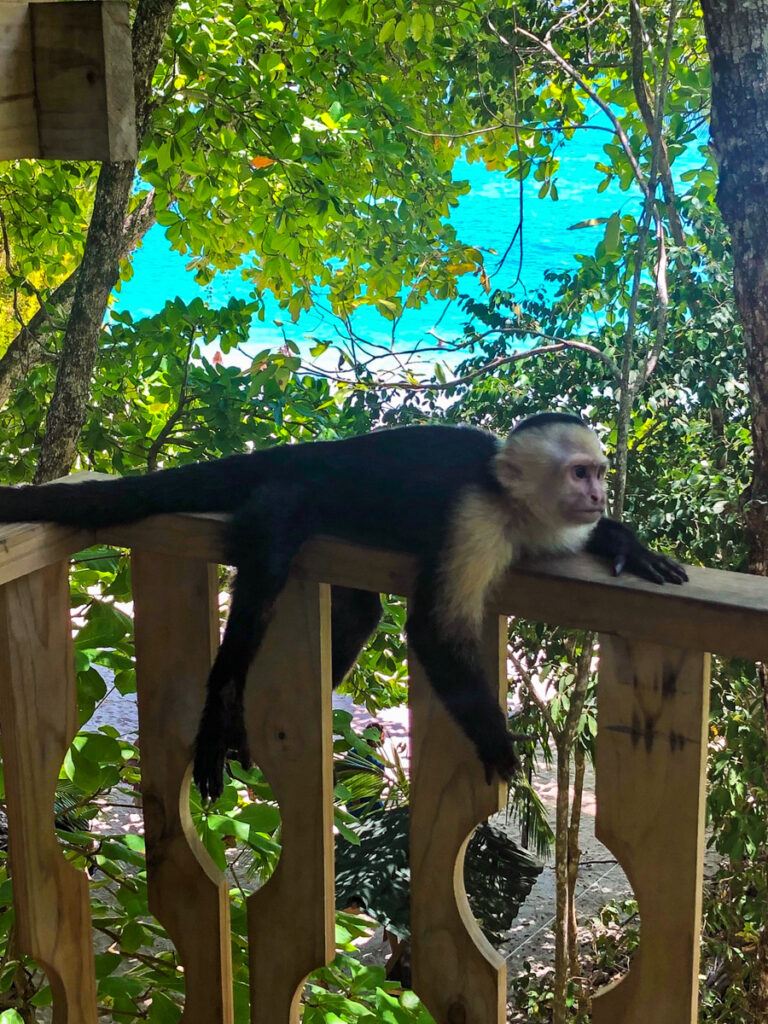
If you’re feeling adventurous, you can zip-line through the jungle or raft down the rapids of the Savegre River. Quepos is also known for its lively nightlife and delicious cuisine.
Manuel Antonio National Park is a tropical paradise of crystal-clear waters, lush green forests, and all of the monkeys.
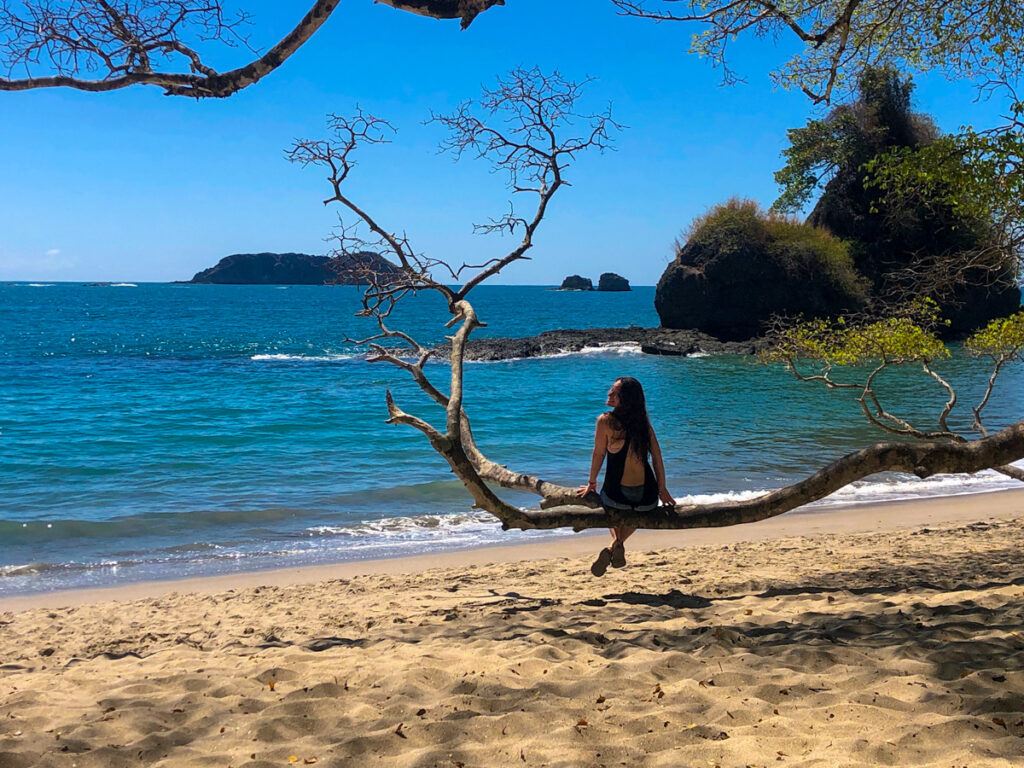
Explore the park’s scenic forest trails and bring a lunch to eat by the beach. But beware: the monkeys here are brave and won’t hesitate to steal your food. Although this is one of the more touristy national parks in Costa Rica, there are some secret secluded spots and beaches. Check out Playa Espadilla Sur to experience just that.
Where to Stay
Budget friendly: Wide Mouth Frog: Rates start at $42 USD
Midrange: La Foresta Nature Resort: Rates start at $130 USD
High end: Santa Juana Lodge and Reserve: Rates start at $188 USD
Where to Next?
Quepos to Jaco
- Head west on Avenida Central toward Calle Luis Gamboa.
- Turn left onto Paseo de los Turistas.
- Continue onto Paseo de los Artesanos.
- Turn right onto the Costanera Sur Highway (Route 34).
- Follow that for approximately 63 kilometers (39 miles).
Driving time: 90 minutes
Jaco
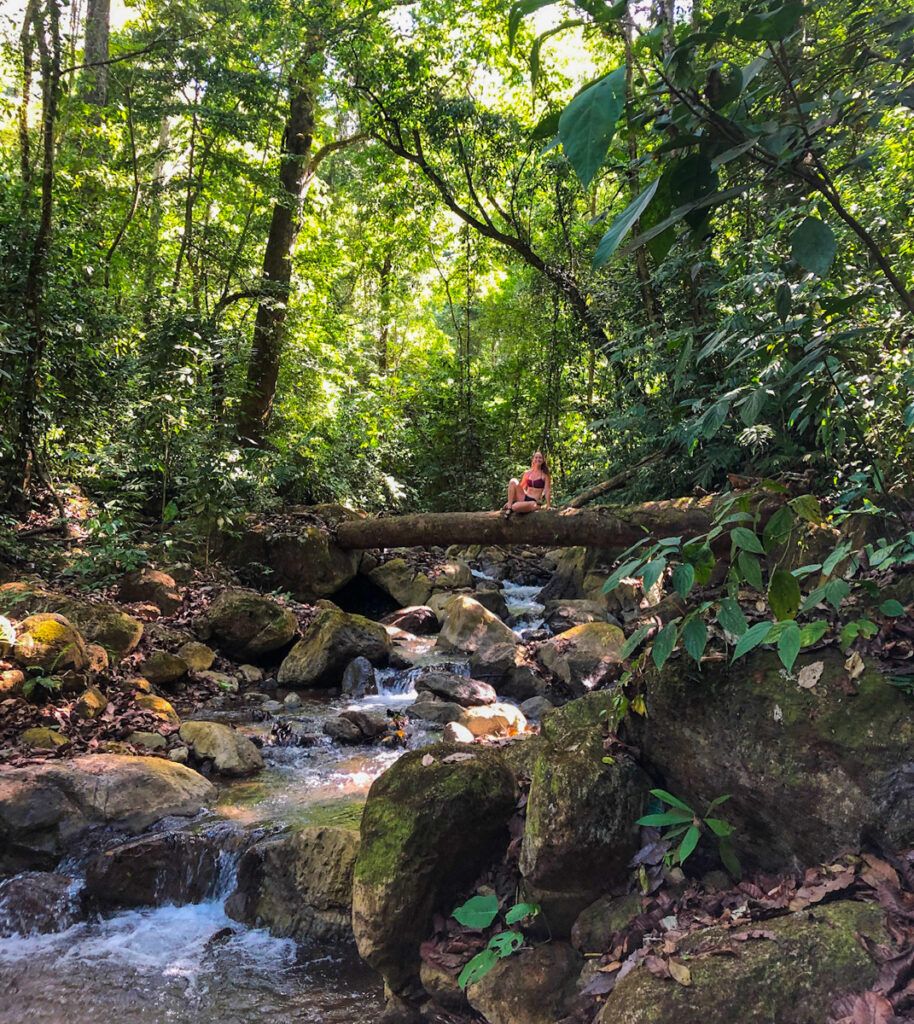
Jaco: where the waves are sky high and the party never stops! This beach town is famous for its surfing, sunsets, and nightlife.
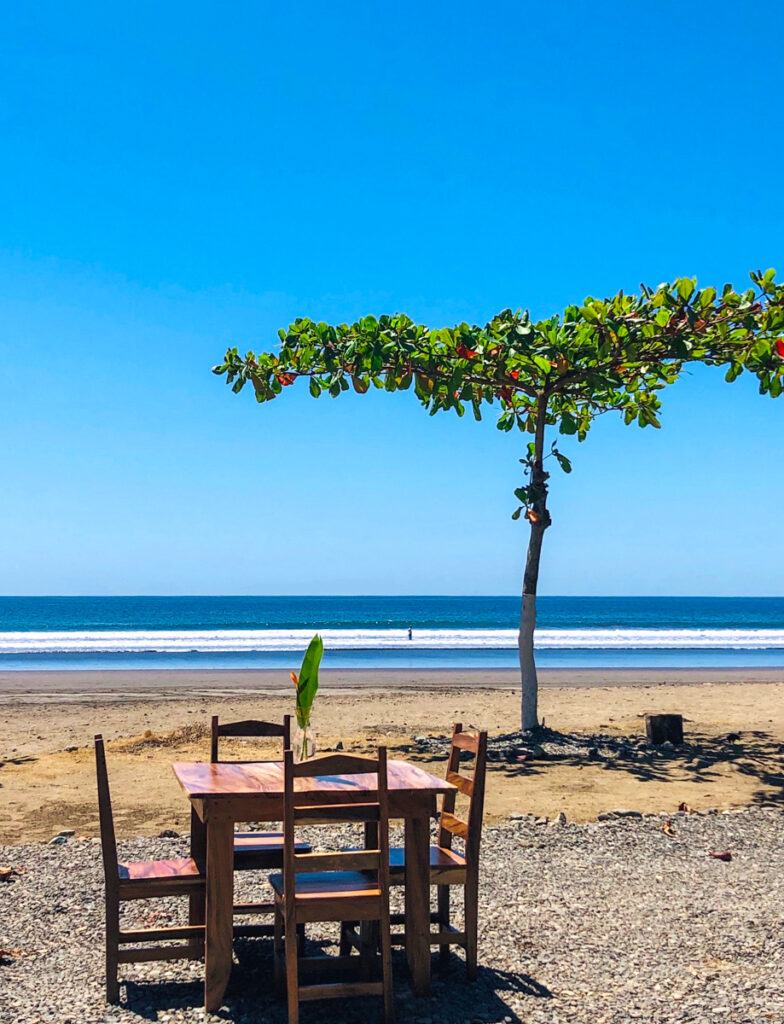
Grab a bite on the beach, explore the town’s vibrant street art scene, or venture off one of the many dirt roads to explore the hidden jungle gems bordering Costa Rica’s national parks.
Where to Stay in Jaco
Budget friendly: Selina Jaco: Rates start at $67 USD
Midrange: Cottage by the River: Rates start at $115 USD
High end: Hotel Bahia Azul: Rates start at $171 USD
Where to Next?
Jaco to Tarcoles River
- Head north on the Costanera Sur Highway (Route 34).
- Continue on that for approximately 18 kilometers (11 miles).
- Turn right onto the bridge over the Tarcoles River.
- Once you cross the bridge, you can stop and take a boat tour on the river to see the crocodiles.
Driving time: 30 minutes
Tarcoles River
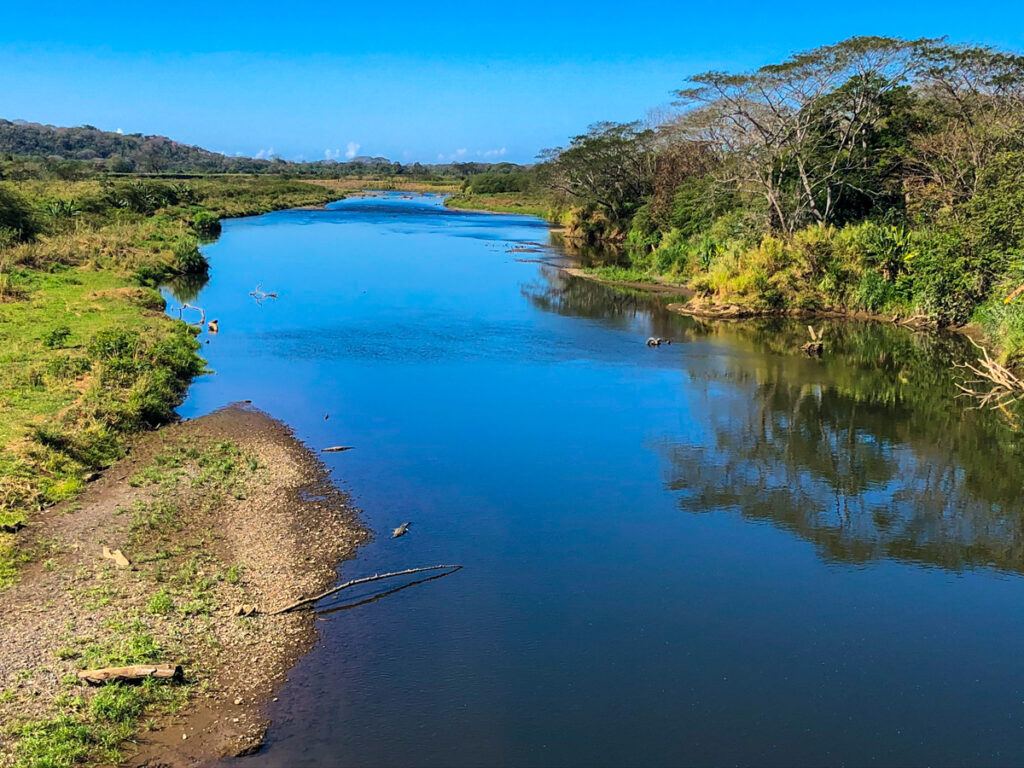
If you’re headed north, you will inevitably cross over the Tarcoles River by way of Costa Rica’s famous Crocodile Bridge. Park at a nearby lot for a small fee (there are plenty on both sides, with bathrooms and souvenir shops) and take a walk along the bridge to peer down at these massive creatures.
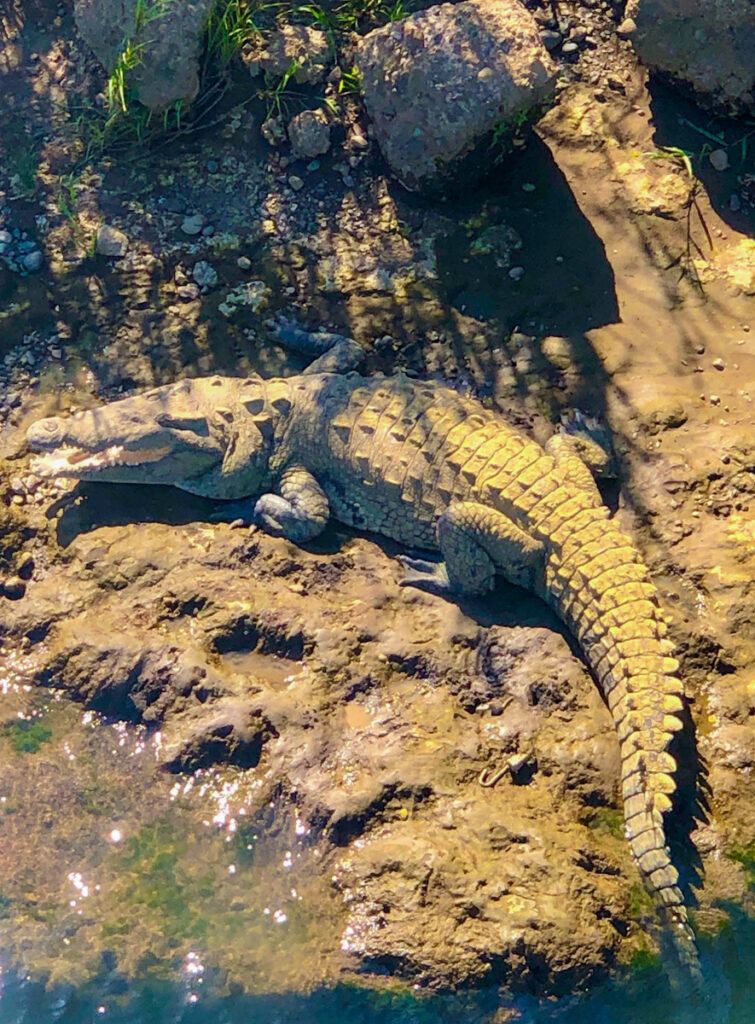
If you’re feeling daring, you can head down toward the river. You won’t get close — and there’s a very tiny fence that I don’t recommend crossing — but you’ll be able to see the crocodiles at ground level.
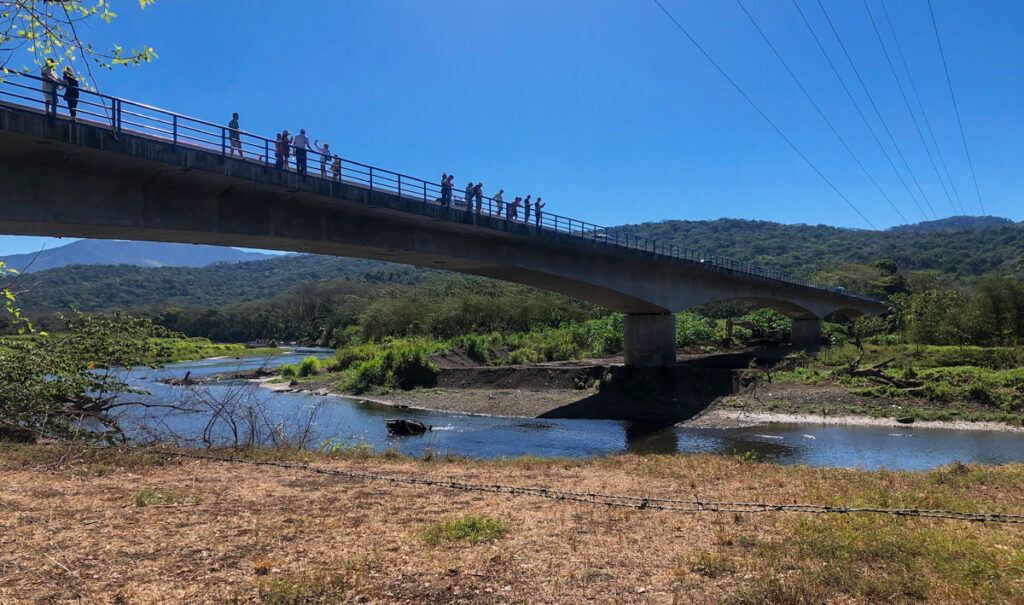
If you really want an experience, take a guided boat tour for an educational experience and an adrenaline rush that brings you up close and personal with Costa Rica’s amazing wildlife.
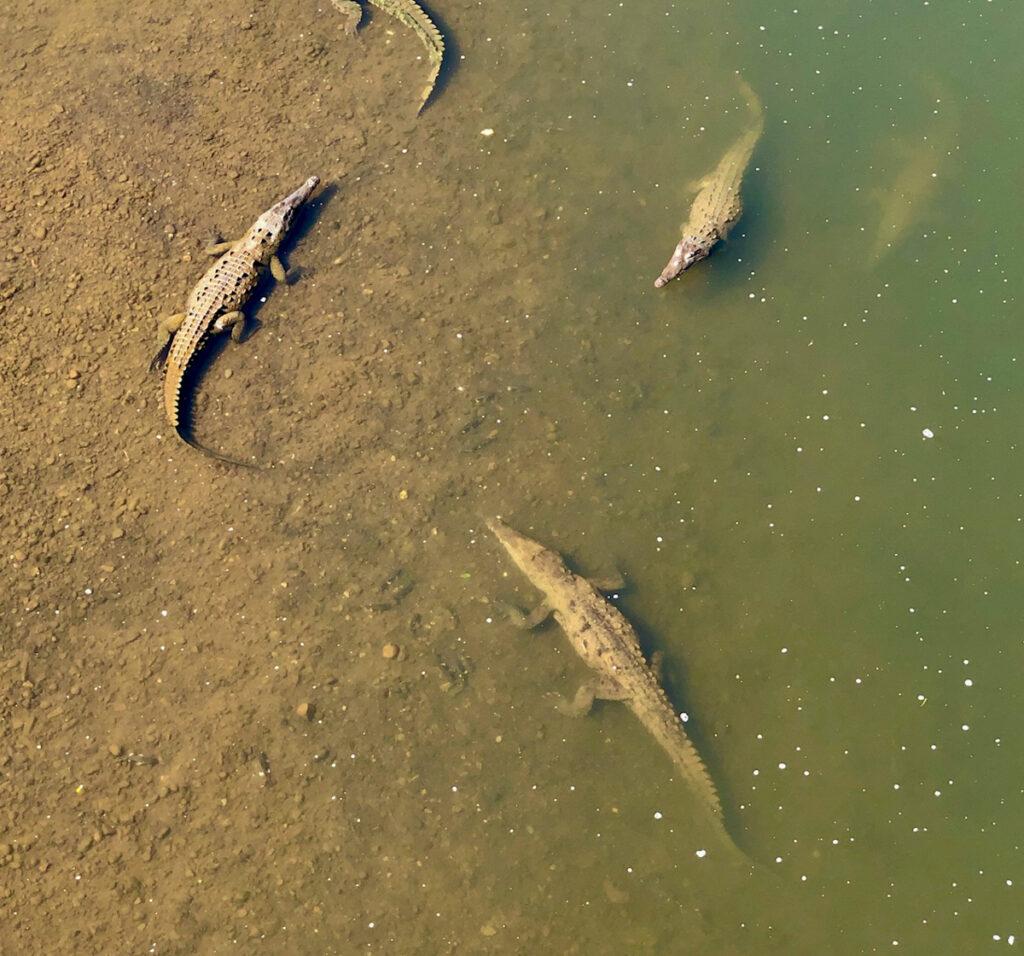
Where to Next?
Tarcoles River to Puntarenas Ferry
- Head north on the bridge over the Tarcoles River.
- Continue straight onto the Costanera Sur Highway (Route 34).
- Follow that for approximately 7 kilometers (4.3 miles).
- Turn left onto Calle 7 and continue straight.
- Turn right onto Avenida 2 and continue straight until you reach the Puntarenas Ferry Terminal.
Driving time: 20 minutes
Ferry time: 90 minutes
Nicoya Peninsula
The Nicoya Peninsula is where time slows down and life is just a little bit more relaxed. Of all the places I traveled to on Costa Rica’s Pacific Coast, this was the least touristy and the most rural. If you’re looking for a break from the crowds, then this is the spot for you.
Puntarenas Ferry
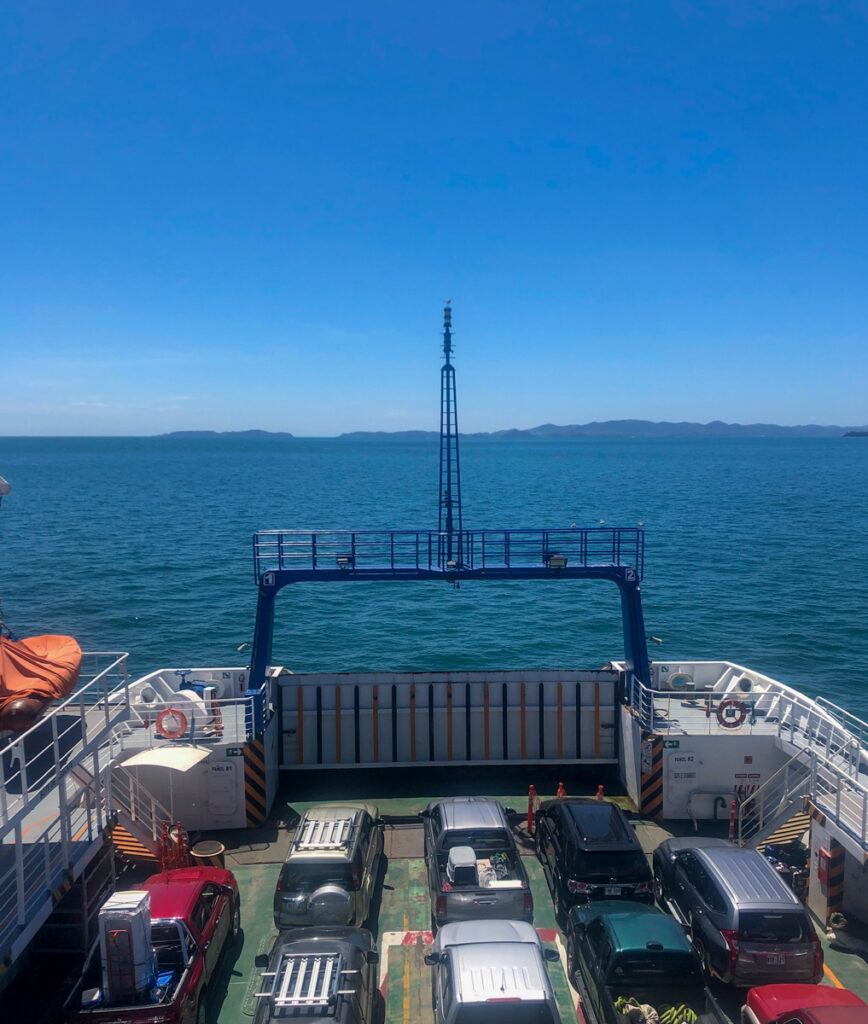
To reach the Nicoya Peninsula, you’ll need to take the Puntarenas Ferry, an hour-long ride on the bay that gives you views of the Pacific coastline and jungle scenery. Keep an eye out for dolphins and whales while you’re at it!
Puntarenas Ferry on the Nicoya Peninsula to Tambor Beach
- Once you arrive at the Paquera Ferry Terminal, drive straight onto Route 160 and follow it for approximately 25 kilometers (15.5 miles).
- Turn left onto Route 21 and continue for about 10 kilometers (6.2 miles).
- Turn right onto Route 160 and proceed for approximately 10 kilometers (6.2 miles) until you reach Tambor Beach.
Driving time: 30 minutes
Tambor Beach
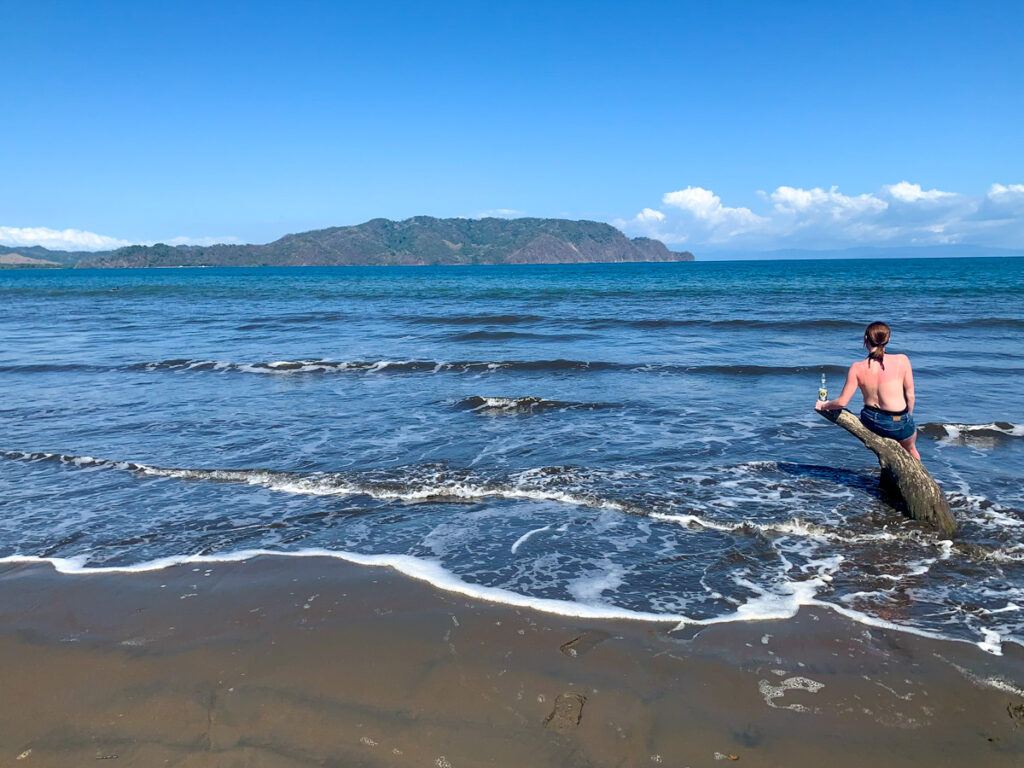
Tambor Beach offers a tranquil, laid-back atmosphere, perfect for those seeking a peaceful escape from the larger cities. The pristine coastline with ultramarine waters is surrounded by lush greenery.
The calm ocean is ideal for swimming, kayaking, and paddleboarding. With macaws, monkeys, and iguanas hanging out nearby, could you pick a better place to disconnect?
Tambor Beach to Santa Teresa
- Head north on Route 160.
- After about 2.5 kilometers (1.5 miles), turn left onto Route 150, which will take you around Tambor Bay.
- After about 9.5 kilometers (5.9 miles), turn right onto Route 21 toward Cobano.
- After approximately 13 kilometers (8 miles), turn right onto Route 160 toward Mal Pais and Santa Teresa.
- Follow Route 160 for about 7 kilometers (4.3 miles) until you reach the crossroad with Route 611.
- Turn left onto Route 611 and follow it for approximately 2.5 kilometers (1.5 miles) until you reach Santa Teresa.
Driving time: 1 hour
Santa Teresa
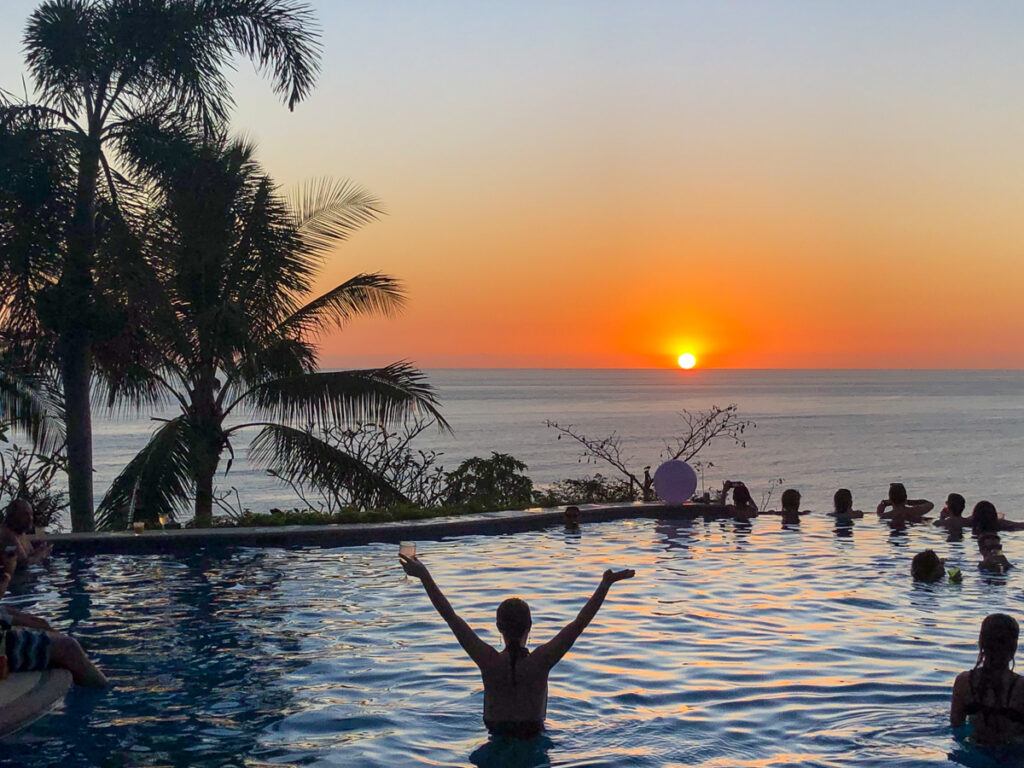
The bohemian surf town of Santa Teresa is home to some of the best waves in the area and is a favorite spot for surfers from around the world. After a day on the water, head to the town center, where you’ll find plenty of bars and restaurants with a chilled-out vibe.
Visit Vista de Olas for dinner and sunset, and if you want to stay overnight, this is definitely someplace I recommend. The laid-back vibe and social atmosphere make for an awesome place to meet new people. The infinity pool overlooking the beach and cliffside made this by far the best sunset I’ve ever seen.
Where to Stay in Santa Teresa
Budget friendly: Salty Enthusiasts Share House and Villa: Rates start at $50 USD
Midrange: Vista de Olas: Rates start at $135 USD
High end: Lua Villas: Rates start at $198 USD
Where to Next?
Puntarenas to Monteverde
- Take the ferry from the Nicoya Peninsula back to Puntarenas.
- Head east on Avenida 3 toward Calle 4.
- Turn left onto Calle 2.
- Turn right onto Avenida 7.
- Continue straight onto Route 18 and follow it for approximately 24 kilometers (15 miles).
- Turn left onto Route 145 and continue for about 6 kilometers (3.7 miles).
- Turn right onto Route 606 and continue for about 16 kilometers (10 miles).
- Turn right onto Route 605 and continue for about 15 kilometers (9.3 miles).
- Turn left onto Route 606 and continue for about 10 kilometers (6.2 miles) until you reach Monteverde.
Monteverde
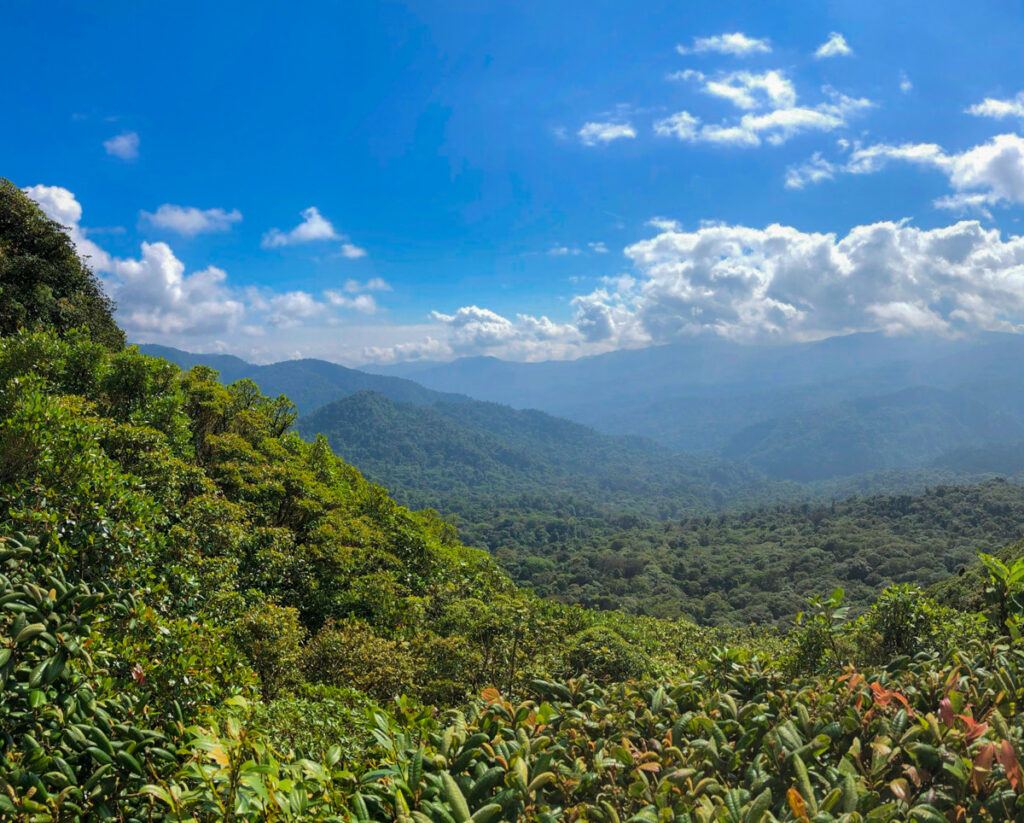
The last stop on our road trip takes you off the coast and inland to Monteverde, Costa Rica, a small town nestled in the mountains and home to a rich array of flora and fauna. The vibes in Monteverde are as slow as the sloths you’ll see in the trees.
Monteverde is known for its lush cloud forests and diverse ecosystem, and visitors can explore the area by hiking, zip-lining, and walking across the famous hanging bridges.
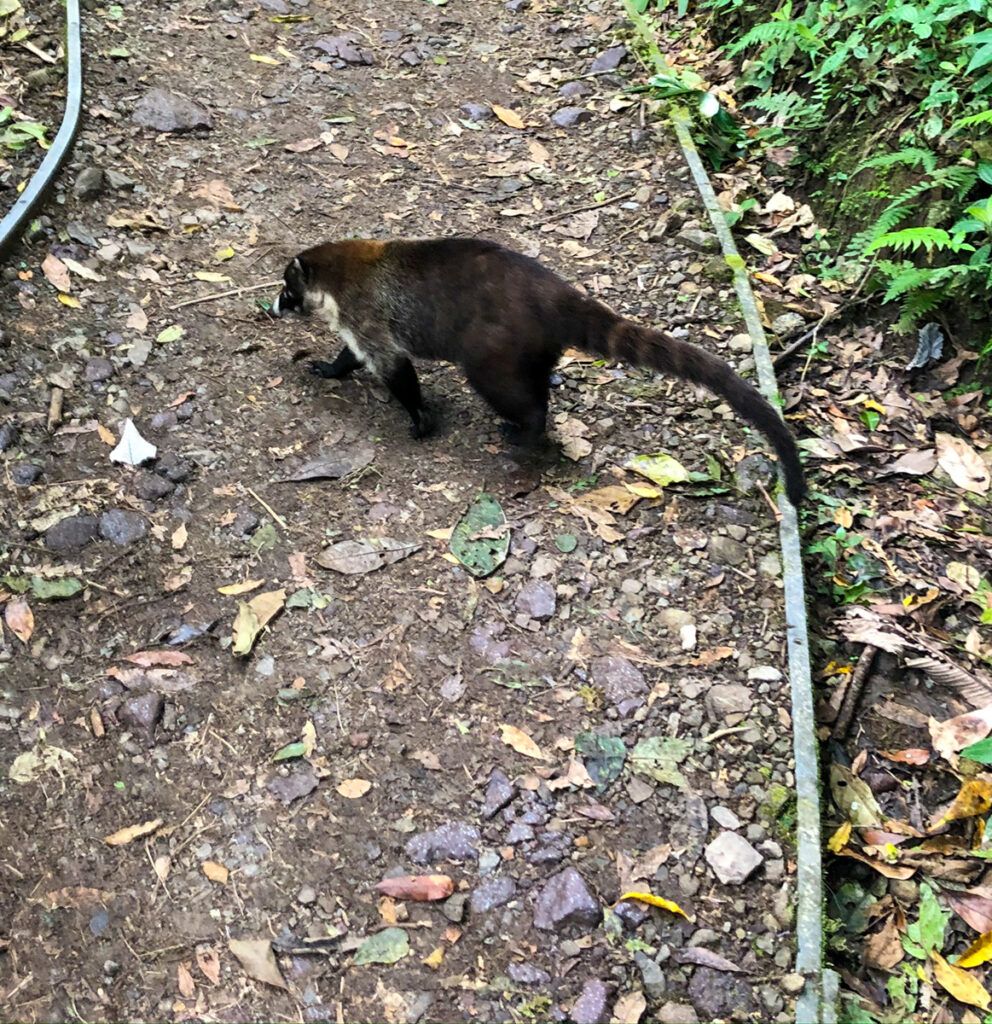
The Monteverde Cloud Forest Reserve is a protected area of over 10,000 hectares (24,711 acres) of forest, which is home to over 400 species of birds, 100 species of mammals, and thousands of species of plants.
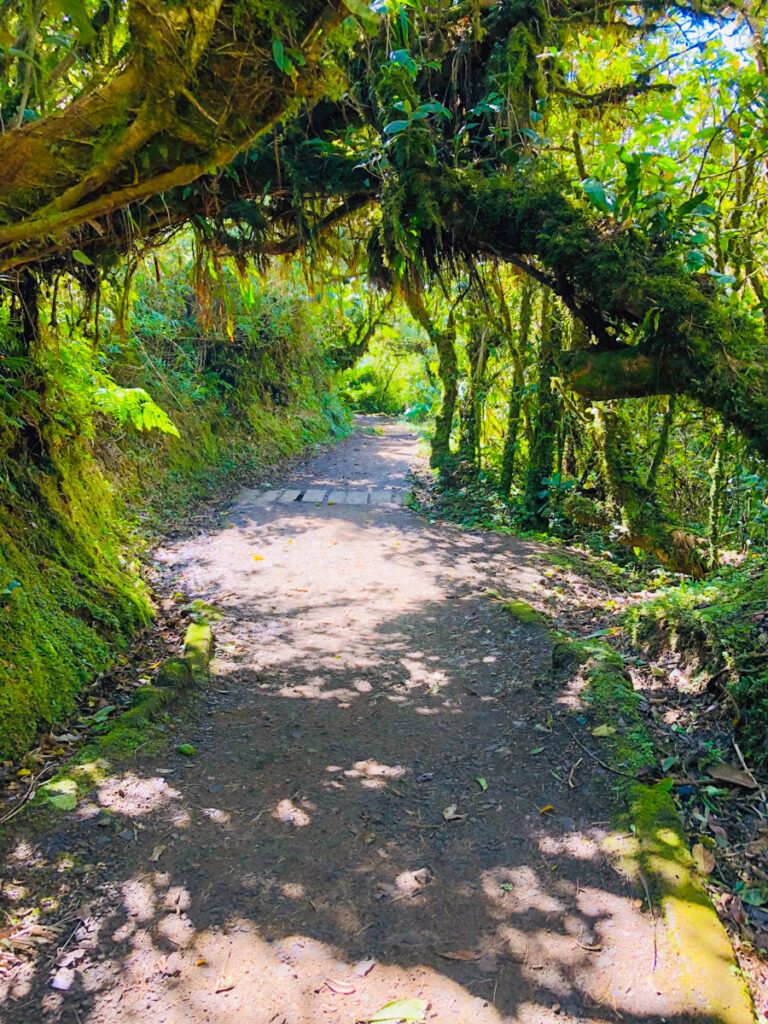
Visitors can hike through the trails of the reserve, go bird-watching, or take a canopy tour to experience the forest from above.
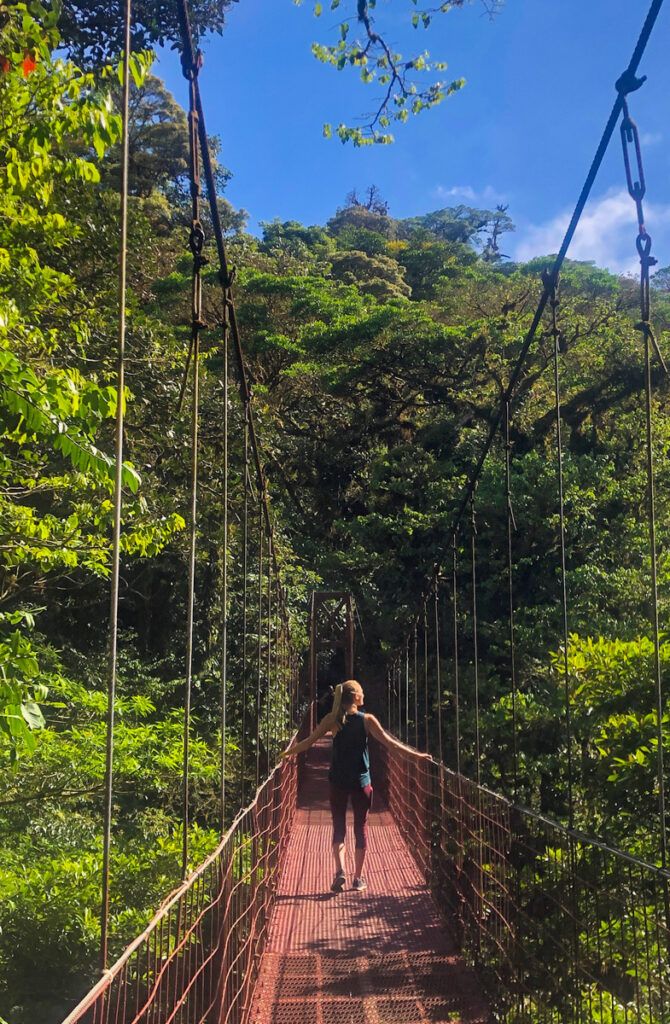
Try out zip-lining or horseback riding, or visit a local farm to learn about sustainable agriculture.
Definitely make sure you have dinner at the Tree House restaurant, built around the canopy of a three-story tree. It offers delicious cuisine and a rustic atmosphere in the center of downtown Monteverde.
Where to Stay in Monteverde
Budget friendly: La Casa de la Montaña: Rates start at $56 USD
Midrange: Casa Mot Mot: Rates start at $85 USD
High end: Green Tea Lodge: Rates start at $110 USD
Where to Next?
That’s it, folks! Head back to San José to round out an exciting and diverse road trip, one you won’t soon forget. I definitely haven’t! And I’m already planning my next trip back.
Monteverde to San José
- Head southeast on Route 606 toward Route 605.
- Turn left onto Route 605 and continue for approximately 15 kilometers (9.3 miles).
- Turn right onto Route 145 and continue for about 6 kilometers (3.7 miles).
- Turn left onto Route 18 and follow it for about 24 kilometers (15 miles) until you reach the Inter-American Highway (Route 1).
- Turn right onto the Inter-American Highway (Route 1) and continue for approximately 105 kilometers (65 miles) toward San José.
- Take the exit to the right toward the airport and continue for about 3 kilometers (1.8 miles) until you reach the airport.
Driving time: 4 hours
What to Bring and When to Go
Bring a camera, to capture all the stunning scenery and wildlife you’re sure to encounter. A Canon EO7 will preserve those memories at a higher quality than your average iPhone — since you’re an avid traveler, you won’t regret the investment!
Don’t forget a towel, because, as any road-tripper knows, it’s one of the most useful things you can have when you’re traveling near the beach. I love my microfiber beach towel. Not only does it dry amazingly quickly, it resists sand and comes with a handy travel bag you can clip onto your suitcase.
A reusable water bottle to stay hydrated and reduce your environmental impact is just as important as a pair of hiking shoes. I swear by my Tevas on trips that take me to the mountains and the beach. And don’t forget the bug spray for those days you venture into the jungle.
Finally, remember to bring your sense of humor, because things don’t always go as planned on a road trip — like when I got locked out of my Airbnb in Cartago on my first night and had to break in. It happens! And sometimes you just have to laugh it off.
The best time to visit Costa Rica depends on your interests and what you want to do during your trip. Costa Rica has two main seasons: the dry season (also known as the high season) and the rainy season (also known as the green season).
The dry season runs from December to April and is considered the best time to visit Costa Rica for outdoor activities such as hiking, beach-going, and wildlife viewing. During this time, the weather is typically sunny and dry, making it ideal for outdoor adventures.
The rainy season runs from May to November, and although it can rain heavily at times, it can also be a great time to visit Costa Rica for nature enthusiasts as the forests are vibrant, and there are fewer tourists. The rainy season can also offer better opportunities for river rafting and waterfall exploring.
Is there anything you’d add to this itinerary to make it more fun?
Leave a Reply